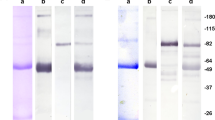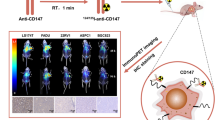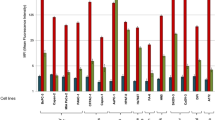Abstract
Antibody targeting has potential for selective delivery of cancer therapy. However, there is a wide variation in the degree of antibody localisation in individual patients with colorectal adenocarcinoma. Colorectal adenocarcinomas are composed of glandular structures separated from fibrovascular stroma by a basal lamina which may represent a significant barrier to extravasated antibody. Basement membrane-associated CEA epitopes may be more accessible to antibodies than those which are cytoplasmic or lumenal. We have investigated by immunohistochemistry and in vivo localisation, the extent to which distribution of antigen epitopes influences targeting. Two monoclonal antibodies (A5B7 and EA77) recognising non-overlapping CEA epitopes were reacted immunohistochemically with samples of 39 tumours. Intensity and site of reaction were assessed for basement membrane, cytoplasmic or lumenal surface association. 125I-labelled antibodies were injected into nude mice bearing LS174T tumour. Per cent injected activity per gram was measured in tumour and normal tissues, 24, 72 and 168 h later. Tissues reacted immunohistochemically for CEA were autoradiographed to assess the relationship of injected antibody to target antigen. Immunohistochemistry showed that A5B7 antibody favours basement membrane aspects of malignant glands; in contrast, EA77 concentrated generally on lumenal surfaces. In vivo localisation showed that per cent inj.act g-1 in tumour for A5B7 reached 36.5% at 24 h. EA77 localised to a lesser extent (9.1% at 24 h), despite a longer circulatory half-life. Autoradiography combined with immunohistochemistry showed A5B7 reacting with antigen close to vasculature after 24 h, slowly penetrating deeper parts of the tumour by 72 h. In contrast, EA77 was confined mainly to fibrovascular stroma, showing little labelling of antigen-positive tumour cells. Localisation differences between A5B7 and EA77 may partly be due to accessibility of epitopes on tumour cells.
This is a preview of subscription content, access via your institution
Access options
Subscribe to this journal
Receive 24 print issues and online access
$259.00 per year
only $10.79 per issue
Buy this article
- Purchase on Springer Link
- Instant access to full article PDF
Prices may be subject to local taxes which are calculated during checkout
Similar content being viewed by others
Author information
Authors and Affiliations
Rights and permissions
About this article
Cite this article
Boxer, G., Abassi, A., Pedley, R. et al. Localisation of monoclonal antibodies reacting with different epitopes on carcinoembryonic antigen (CEA) – implications for targeted therapy. Br J Cancer 69, 307–314 (1994). https://doi.org/10.1038/bjc.1994.56
Issue Date:
DOI: https://doi.org/10.1038/bjc.1994.56
This article is cited by
-
Quantitative intratumoural microdistribution and kinetics of 131I-huA33 antibody in patients with colorectal carcinoma
EJNMMI Research (2014)
-
A phase I trial of antibody directed enzyme prodrug therapy (ADEPT) in patients with advanced colorectal carcinoma or other CEA producing tumours
British Journal of Cancer (2002)
-
Human Antibodies with Sub-nanomolar Affinities Isolated from a Large Non-immunized Phage Display Library
Nature Biotechnology (1996)



